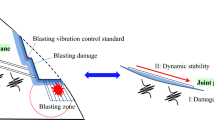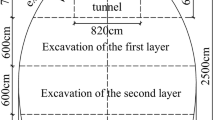Abstract
Due to complex geological conditions and strict requirements of excavation shaping and damage control for the breccia lava dam foundation, the development of a suitable dam foundation excavation technique become one of the most challenging technical issues during the construction of the Bai-he-tan hydropower station. To resolve this challenge, this paper develops a new energy-relief blasting (ERB) technique that uses a shock-relief structure arranged at the bottom of a borehole. The energy-relief structure consists of a spherical energy-relief block with high sonic impedance and a flexible cushion with low sonic impedance. The resulting reflection of the stress wave at the spherical shock-reflection block surface and the buffer effect of the flexible cushion can help to reduce the damage caused by the explosion load on the foundation rock mass. Furthermore, considering the irregular surface of breccia lava, the vertical boreholes used in ERB can solve the problem of drilling horizontal boreholes when using traditional excavation techniques, markedly improve construction speed. To verify the quality of the excavation shaping of the new technique, three comparative experiments were carried out at the Bai-he-tan hydropower station during field production. The results indicate that the ERB excavation technique can effectively control blast-induced damage in the host rock, protect the foundation rock mass, and yield a smooth foundation surface. Owing to the good excavation quality and high construction efficiency of the new technique, ERB has been successfully applied to the excavation of the left bank of the breccia lava dam foundation on a large scale. This new technique has wide application prospects in dam foundation excavation and other engineering fields.



























Similar content being viewed by others
References
Achenbach JD (1973) Wave propagation in elastic solids. North-holland Publishing, New York
Chen S (2015) Chapter 8 arch dams hydraulic structures. Springer, Berlin, pp 397–496
Chen B, Li Q, Feng X et al (2014) Microseismic monitoring of columnar jointed basalt fracture activity: a trial at the Bai-he-tan Hydropower Station, China. J Seismol 18(4):773–793 (in Chinese)
Chen Y, Zhang L, Yang B, Dong J, Chen J (2015) Geomechanical model test on dam stability and application to Jinping High arch dam. Int J Rock Mech Min 76:1–9
Dreese TL, Wilson DB, Heenan DM, Cockburn J (2003) State of the art in computer monitoring and analysis of grouting. In: Johnsen LF, Bruce DA, Byle MJ (eds) Proceedings of the third international conference on grouting and ground treatment, Geotechnical Special Publication, vol 120. ASCE. Reston, VA, pp 1440–1453
Ewert F (1985) Rock grouting with emphasis on dam sites. Springer, Berlin
Fan Q, Wang Z, Xu J, Zhou M, Jiang Q, Li G (2017) Study on deformation and control measures of columnar jointed basalt for Baihetan super-high arch dam foundation. Rock Mech Rock Eng 51(2):1–27
Fei W, Zhang L, Zhang R (2010) Experimental study on a geo-mechanical model of a high arch dam. Int J Rock Mech Min Sci 47(2):299–306
Fransson Å, Tsang CF, Rutqvist J, Gustafson G (2007) A new parameter to assess hydromechanical effects in single-hole hydraulic testing and grouting. Int J Rock Mech Min Sci 44(7):1011–1021
Gudmundsson A (2012) Magma chambers: formation, local stresses, excess pressures, and compartments. J Volcanol Geotherm Res 237–238:19–41
Gudmundsson A, Løtveit IF (2014) Sills as fractured hydrocarbon reservoirs: examples and models. Geol Soc Lond Spec Publ 374(1):251–271
Hu Y, Lu W, Chen M, Yan P, Yang J (2014) Comparison of blast induced damage between presplit and smooth blasting of high rock slope. Rock Mech Rock Eng 47:1307–1320
Hu H, Lu W, Yan P, Chen M, Gao Q, Yang Z (2017) A new horizontal rock dam foundation blasting technique with a shock-reflection device arranged at the bottom of vertical borehole. Eur J Environ Civil Eng. https://doi.org/10.1080/19648189.2017.1399168
Hu H, Lu W, Yan P, Chen M, Gao Q (2018) A vibration-isolating blast technique with shock-reflection device for dam foundation excavation in complicated geological conditions. Shock Vib 2018:1–11
Jiang Q, Feng X, Hatzor YH, Hao X, Li S (2014) Mechanical anisotropy of columnar jointed basalts: an example from the Bai-he-tan hydropower station, China. Eng Geol 175:35–45 (in Chinese)
Jin F, Hu W, Pan J, Yang J, Wang J, Zhang C (2011) Comparative study procedure for the safety evaluation of high arch dams. Comput Geotech 38(3):306–317
Kikuchi K, Igari T, Mito Y, Utsuki S (1997) In situ experimental studies on improvement of rock masses by grouting treatment. Int J Rock Mech Min Sci 34(3–4):594
Li J, Ma G (2010) Analysis of blast wave interaction with a rock joint. Rock Mech Rock Eng 43(6):777–787
Li H, Xia X, Li J (2010) Rock damage control in bedrock blasting excavation for a nuclear power plant. Int J Rock Mech Min Sci 48(2):210–218
Liu H, Wang M (2011) Numerical analysis of damage to retained rock mass of dam foundation caused by blasting excavation. Adv Mater Res 255–260:4256–4261
Lu W, Hu Y, Yang J, Chen M, Yan P (2013) Spatial distribution of excavation induced damage zone of high rock slope. Int J Rock Mech Min Sci 64:181–191
Mallet R (1875) On the origin and mechanism of production of the prismatic (or columnar) structure of basalt. Philos Mag 50(4):122–135
Mandal SK, Singh MM, Dasgupta S (2008) Theoretical concept to understand plan and design smooth blasting pattern. Geotech Geol Eng 26(4):399–416
Mgalobelov YB (2000) Advanced techniques in designing and building concrete dams. Hydrotech Constr 34(8):415–422
Ministry of Water Resources and Ministry of Electric Power Industry of People’s Republic of China (2007) Construction technical specifications on rock-foundation excavating engineering of hydraulic structures (DLT5289-2007). China Water Power Press, Beijing (in Chinese)
Novozhilov MS, Oganesyan GA (1978) Preparation of the foundation for a high rolled-fill earth dam. Hydrotech Constr 12(4):340–344
Park D, Byungkyu J, Seokwon J (2009) A numerical study on the screening of blast-induced waves for reducing ground vibration. Rock Mech Rock Eng 42(1):449–473
Peck DL, Minakami T (1968) The formation of columnar joints in the upper part of Kilauean lava lakes. Geol Soc Am Bull 79:1151–1166
POWERCHINA HUADONG (2011a) The engineering geological research report of Bai-he-tan hydropower station. Huadong Engineering Corporation Limited, Hangzhou
POWERCHINA HUADONG (2011b) The feasibility study report of Bai-he-tan hydropower station. Huadong Engineering Corporation Limited, Hangzhou
Rathore SS, Bhandari S (2007) Controlled fracture growth by blasting while protecting damages to remaining rock. Rock Mech Rock Eng 40(3):317–326
Schultz RA (1995) Limits on strength and deformation properties of jointed basaltic rock masses. Rock Mech Rock Eng 28(1):1–15
Shen X, Niu X, Lu W, Chen M, Yan P, Wang G, Leng Z (2016) Rock mass utilization for the foundation surfaces of high arch dams in medium or high geo-stress regions: a review. Bull Eng Geol Environ 76(2):795–813
Shi A, Tang M, Zhou Q (2008) Research of deformation characteristics of columnar jointed basalt at Bai-he-tan hydropower station on Jinsha river. Chin J Rock Mech Eng 27(10):2079–2086 (in Chinese)
Stille H, Gustafson G, Hassler L (2012) Application of new theories and technology for grouting of dams and foundations on Rock. Geotech Geol Eng 30(3):603–624
Wu F, Liu J, Liu T, Zhuang H, Yan C (2009) A method for assessment of excavation damaged zone (EDZ) of a rock mass and its application to a dam foundation case. Eng Geol 104(3):254–262
Zhang Y, Lu W, Chen M, Yan P, Hu Y (2013) Dam foundation excavation techniques in China: a review. J Rock Mech Geotech Eng 5(6):460–467
Zhang L, Liu Y, Yang Q (2015) Evaluation of reinforcement and analysis of stability of a high-arch dam based on geomechanical model testing. Rock Mech Rock Eng 48(2):803–818
Zou Y, Li J, He L, Lyesse L, Zhao J (2016) Wave propagation in the vicinities of rock fractures under obliquely incident wave. Rock Mech Rock Eng 49(5):1789–1802
Acknowledgements
The authors gratefully appreciate the supports from the National Natural Science Foundation of China (51779190), Hubei Province Technical Innovation Program (2017ACA102), the Technology and Industry for National Defense of China (no. JCKY2018110). Also the field experiments were support the Sino hydro Bureau 8 Co., LTD. The authors wish to express their thanks to all supporters.
Author information
Authors and Affiliations
Corresponding author
Ethics declarations
Conflict of Interest
The authors declare that they have no conflicts of interest to this work.
Additional information
Publisher's Note
Springer Nature remains neutral with regard to jurisdictional claims in published maps and institutional affiliations.
Rights and permissions
About this article
Cite this article
Liu, G., Lu, W., Niu, X. et al. Excavation Shaping and Damage Control Technique for the Breccia Lava Dam Foundation at the Bai-he-tan Hydropower Station: A Case Study. Rock Mech Rock Eng 53, 1889–1907 (2020). https://doi.org/10.1007/s00603-019-02013-1
Received:
Accepted:
Published:
Issue Date:
DOI: https://doi.org/10.1007/s00603-019-02013-1




